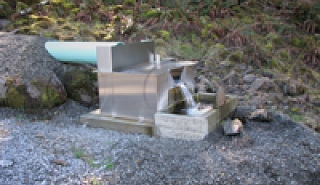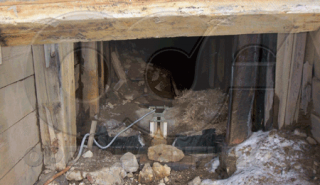Open feedlots are common throughout North America. Although they provide an economical way to feed and raise a variety of livestock, such operations generate large quantities of runoff that have considerably elevated nutrient levels (ammonia, nitrogen, and phosphorous) as well as total suspended solids.
To ensure that ground and surface waters are not impacted by runoff from feedlots it is important to capture, measure, and treat all runoff flows before they reach groundwater sources.

To provide a scale for the amount of waste produced in a typical feedlot, consider that a 1,000-pound cow produces about 12.0 gallons of fresh manure (solids and liquids) per day. At that rate, a typical 1,000-animal beef feedlot will produce on average 84,000 gallons of manure in one week. With roughly 1,800 feedlots with 1,000 animals or more in this United States, this means that these operations alone generate 151.2 million gallon of manure per week (or 55.2 billion of gallons per year).

Much of this waste is used as fertilizer or otherwise disposed of. However, there is still considerable liquid waste to monitor – an amount that increases dramatically during rain events where the impermeable concrete of the feedlot collects and ponds rainfall - mixing it with the waste already present.
Using Weirs
For runoff applications, weirs have the distinct advantage of being cheap to construct. However, when total life-cycle costs are considered, a flume is usually a better choice in a feedlot application.
There are two problems in applying weirs to measure feedlot runoff: weir pool sizing and maintenance.
For a weir to operate correctly a proper weir pool must be formed upstream. A weir pool serves to condition the flow approaching a weir and also provides the point of measurement at which the head is measured. Properly sized, weir pools can result in considerable amounts of standing water, which is not always desirable (or possible).
Although simple to construct, weirs require continual maintenance is all but the clearest of applications. Feedlot runoff is particularly high in suspended solids and these solids tend to settle out in the weir pool. Additionally, feedlot waste contains stringy, vegetative matter which can collect on the weir crest
Feedlot weirs are usually fabricated from T-304 stainless steel. Stainless steel is strong, easy to fabricate, and is resistant to rounding of the upstream crest edge, which can affect measurement accuracy.
Using Flumes
Flumes work well in monitoring runoff from animal feedlots. Requiring about a fourth the head of a similarly sized weir, flumes usually generate much less upstream ponding and pass solids considerably better.
Of the various classes of flume available, the H Flume has shown to work well. Although Parshall flumes are sometimes used in the application.

H Flumes require little in the way of maintenance; possessing a flat floor which allows for the passage of silt and sediments readily. The V-shaped discharge of the flume proivdes excellent minimum flow rates while still allowing for a wide measurement span, allowing the H Flume to capture peak storm water flows as well as average daily flows.
H Flumes also have the ability to be recessed into the bank of a feedlot, with flow spilling into an approach section and then into the flume - all with a minimal impact on measurement accuracy.
Sources: Clemson University, Progressive Dairy, Texas Water Resources Institute, U.S. Department of Agriculture – Agricultural Research Service





